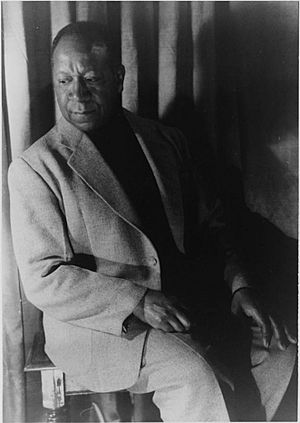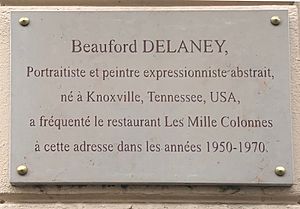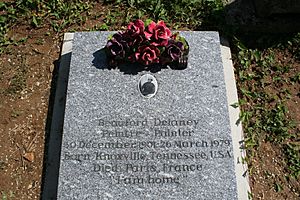Beauford Delaney facts for kids
Quick facts for kids
Beauford Delaney
|
|
|---|---|

Beauford Delaney, photographed by Carl Van Vechten in 1953
|
|
| Born | December 30, 1901 Knoxville, Tennessee, U.S.
|
| Died | March 26, 1979 (aged 77) Paris, France
|
| Resting place | Thiais Cemetery Paris, France |
| Nationality | American |
| Known for | Painting |
| Movement | Harlem Renaissance |
Beauford Delaney (December 30, 1901 – March 26, 1979) was an American modern painter. He is known for his work during the Harlem Renaissance in the 1930s and 1940s. Later, he created abstract paintings after moving to Paris in the 1950s. Beauford's younger brother, Joseph, was also a famous painter.
Contents
Beauford Delaney: An Artist's Journey
Early Life and Art
Beauford Delaney was born on December 30, 1901, in Knoxville, Tennessee. His parents, Samuel and Delia, were respected members of the black community. Samuel was a barber and a Methodist minister. Delia worked doing laundry and cleaning. She taught her children about dignity and the importance of education. Beauford was one of ten children, but only four lived to adulthood.
Beauford and his brother Joseph loved art from a young age. They copied pictures from Sunday school cards and the family bible. Beauford was outgoing, while Joseph was more shy. They both attended Austin High School. One of Beauford's early works was a portrait of the school principal.
As a teenager, Beauford worked at the Post Sign Company. His art was noticed by Lloyd Branson, a well-known artist in Knoxville. Branson encouraged Beauford to study art. At 23, Beauford moved to Boston to learn more. He studied at several art schools, learning classical painting techniques. By 1929, his art education was complete, and he moved to New York City.
Life in New York City
Beauford arrived in New York City during the exciting Harlem Renaissance. This was a time when black culture was thriving in the United States. However, it was also the time of the Great Depression. Many people were out of work and struggled to find food and shelter.
Delaney felt a connection with these people. Their courage inspired him to keep going despite the challenges. He painted many of these people and city scenes. His paintings from this time show the city's character. They also express his belief in equality and respect for all people.
One of his famous works from this time is Can Fire in the Park (1946). It shows men huddling around a fire for warmth. The Smithsonian American Art Museum says it shows the struggles of poor black Americans. Despite the serious topic, the painting is full of energy. Delaney used bright colors and thick paint. His style moved from realistic to more expressive.
Delaney found ways to show his work during the Depression. He worked as a guard and telephone operator at the Whitney Museum. This helped him get a studio space and a place to live.
He became part of the art scene, making friends with famous people. These included poet Countee Cullen and artist Georgia O'Keeffe. He also became a mentor to the young writer James Baldwin. Despite his friendships, Delaney often felt isolated. He kept parts of his life separate from each other.
He was also influenced by European modern artists like Cézanne, Matisse, Picasso, and Van Gogh. He tried to include African-American influences, like jazz music, in his art. He was proud of black achievements. He showed his work in exhibitions with other black artists.
Even with some success, Delaney often faced poverty. Writer Brooks Atkinson noted that Beauford lived simply. He worked on a painting style that few understood. Yet, his paintings were never depressing. They showed his strength and ability to find joy despite difficulties.
Moving to Paris
In 1953, at age 52, Delaney moved from New York to Paris, France. Many other African-American artists and writers had moved to Europe. They found more freedom there. Writers like Richard Wright and James Baldwin had already gone. Wright called Paris "a place where one could claim one's soul."
Europe became Delaney's home for the rest of his life. He hoped to find faith and love there. He wanted to learn to suffer deeply but quietly.
His time in Paris changed his art style. He moved from painting scenes of New York life to abstract studies of color and light. Delaney was actually exploring abstract art before it became widely known. His abstract works gained attention in the late 1940s.
Even though he focused on abstract art, he still painted people. His portrait of James Baldwin (1963) is a good example. It uses bright, glowing yellow colors, inspired by Van Gogh. The portrait shows Baldwin's face and is also a study of light.
Delaney was so driven to paint that he sometimes used his raincoat as a canvas. One painting, "Untitled, 1954," is oil on a raincoat piece.
Later Years and Challenges
By 1961, Beauford began to face health challenges. He had periods of clear thinking, but also times of confusion. This continued for the rest of his life.
James Baldwin said that Beauford had struggled his whole life. He faced many difficulties but always found a way to survive. Baldwin admired how Beauford overcame inner and outer darkness.
Delaney briefly returned to the United States in 1969 to see his family. He continued to struggle with his health. After returning to Paris in 1970, he showed signs of illness. His friends tried to care for him. In 1975, he was hospitalized. Beauford Delaney passed away in Paris on March 26, 1979. He had asked for a simple burial.
James Baldwin wrote that Beauford's early life in Tennessee was very difficult. He wondered what strength allowed Beauford to make such a determined and wonderful journey.
His Legacy
After his death, Beauford Delaney was recognized as a great painter. However, his work was still often overlooked.
An exhibition of his work in 1988 in New York helped bring his art back into public view. More exhibitions followed. People started to ask why such a respected artist had become almost unknown. Some thought it was because he moved to Paris when New York became the center of the art world. Others believed his work didn't fit the art trends of the time.
Today, art history is seen in a broader way. This allows artists like Delaney to be appreciated more fully.
In 1985, James Baldwin spoke about Delaney's impact on his life. He said Delaney was the first black man he knew who was an artist. Baldwin called him his "Master" and an example of courage and honesty. He admired Delaney's ability to show light in his paintings, even though his life was often dark. Baldwin believed Delaney was a truly great painter. He said great art comes from love, and no one loved more than Beauford.
Delaney's work has been shown in many important museums. These include the Philadelphia Museum of Art, Art Institute of Chicago, and the Smithsonian American Art Museum.
The TV show Flatbush Misdemeanors pays tribute to Delaney. One of the characters teaches at a fictional "Beauford Delaney High School."
The Beauford Delaney Burial Site
In 2009, a writer named Monique Y. Wells learned that Delaney was buried in an unmarked grave in Paris. His burial spot was going to be removed if the fee wasn't paid. Friends of Delaney raised money, and Wells paid the fee to save his resting place.
These friends wanted to place a tombstone at his grave. Wells started a French non-profit group called Les Amis de Beauford Delaney. They raised enough money by June 2010. The tombstone was installed by August 2010.



